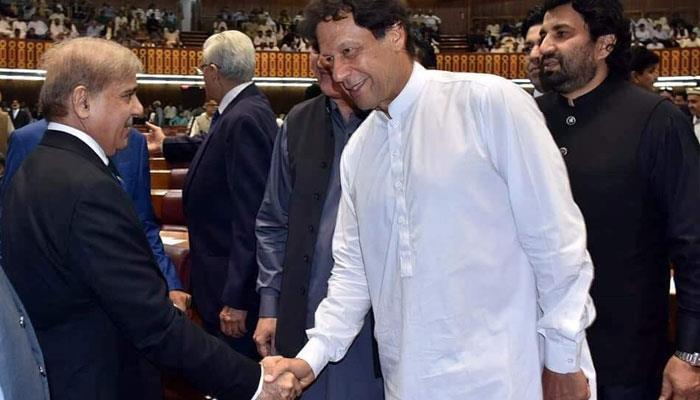Although the constitutional tenure of the National Assembly was scheduled to conclude at 12 o'clock on August 12, the Prime Minister forwarded the dissolution summary to the President three days ago. Following the President's endorsement, the National Assembly has now been dissolved .
In the event of assembly dissolution before its stipulated tenure, the constitutional responsibility of conducting elections within 90 days falls on the Election Commission. If the assembly completes its full term, elections are constitutionally mandated to be held within 60 days.
Discussions are underway within the country regarding the timing of the upcoming elections, ranging from possibilities of elections within three to four months or the caretaker setup's extension until March. The course of action will be determined only once the name of the caretaker prime minister is finalized.
Ongoing consultations between Prime Minister Shehbaz Sharif and opposition leader Raja Riaz concerning the caretaker prime minister selection indicate the potential for reaching an agreement on the prime ministerial candidate today.
Preceding the 2002 election, no government in the nation's history had managed to complete a full five-year constitutional term. However, from 2002 to 2023, four consecutive assemblies successfully fulfilled their five-year constitutional terms. Notably, over the 75-year history of the country, no prime minister has served a complete five-year term.
Haq on August 17, 1988, the Pakistan People's Party secured 94 seats in the National Assembly during the sixth general election held on November 16, 1988. Backed by a coalition of other parties, Benazir Bhutto assumed office as Pakistan's first female Prime Minister on December 2, 1988, a historic milestone not only for the country but also for the broader Islamic world. However, her tenure was short-lived, lasting barely two years, as then-President Ghulam Ishaq Khan terminated her rule.The 1990 elections saw the Pakistan Muslim League gain a majority, leading to Muhammad Nawaz Sharif of the Muslim League becoming the Prime Minister of Pakistan for the first time on August 6, 1990. Sharif's government endured for two and a half years.
Relations between Prime Minister Nawaz Sharif and President Ghulam Ishaq Khan were strained. Consequently, on April 18, 1993, the assembly was dissolved, and Balkh Sher Mazari took on the role of caretaker prime minister.
On May 26, 1993, Nawaz Sharif returned as Prime Minister, only to resign two months later. Subsequently, on October 19, 1993, Benazir Bhutto commenced her second term as Prime Minister. Her government lasted for two and a half years before then-President Farooq Leghari removed her from power. Malik Miraj Khalid was appointed caretaker prime minister, and elections were held. On February 17, 1997, luck favored Nawaz Sharif, and he regained the position of prime minister.
After serving as Prime Minister for nearly two years, then-Army Chief General Pervez Musharraf seized control on October 12, 1999. He overthrew the government led by Nawaz Sharif, who was subsequently imprisoned in Attock Jail and assumed power himself.
Prime Ministers of Pakistan (2002-2023)
Before 2002, the political landscape saw a series of changing assemblies. However, in 2008, a historic shift occurred as a democratic government smoothly transferred power to another, initiating an ongoing trend. While governments consistently completed their terms, the prime ministerial tenure could not achieve the full 5-year constitutional span.
In the 2002 general election, PML-Q candidate Mir Zafarullah Khan Jamali assumed the role of Prime Minister from November 23, 2002, until June 26, 2004. Following his resignation due to various factors, Chaudhry Shujaat Hussain briefly occupied the position for a few months. Subsequently, Shaukat Aziz, returning from the United States, took office on August 28, 2004, and served as prime minister until the assembly's term concluded on November 15.
On November 16, 2007, Mian Muhammad Soomro took up the position of Caretaker Prime Minister. Tragically, before the 2008 elections, the first woman prime minister of the Muslim world, Benazir Bhutto, was assassinated in Liaquat Bagh, Rawalpindi. Following a delay, elections were conducted, and Yousuf Raza Gilani from Multan became the Prime Minister of Pakistan on March 25, 2008.
Gilani's prime ministership extended for four years, after which he was disqualified by the Supreme Court. Raja Pervaiz Ashraf succeeded him and held the office from June 22, 2012, to March 24, 2013, concluding his term.
Mir Hazar Khan Khoso served as caretaker prime minister from March 25, 2013, to June 5, 2013. The 2013 elections saw the Pakistan Muslim League-Nawaz (PML-N) secure a clear majority in the National Assembly, leading to Mian Nawaz Sharif's fourth term as Prime Minister on June 5, 2013. Despite the assembly majority, Nawaz Sharif couldn't complete his full term.
Disqualified on July 28, 2017, by the Supreme Court in the Panama case, Shahid Khaqan Abbasi succeeded him on August 1, 2017. Abbasi held the office until the assembly's term ended on May 31, 2018. Justice (retd) NasirMulk then served as the Caretaker Prime Minister from June 1, 2018, to August 18, 2018.The 2018 elections witnessed Pakistan Tehreek-e-Insaf (PTI) garner a significant majority in the National Assembly, leading to Imran Khan's swearing-in as the 22nd Prime Minister of Pakistan on August 18, 2018. Khan's tenure was anticipated to mark the first completion of a full five-year term, given his rapport with the establishment.
However, on April 10, 2022, Imran Khan was ousted from power through a successful no-confidence motion. Shahbaz Sharif succeeded him on April 11, becoming the 23rd Prime Minister of Pakistan.
Recently, Prime Minister Shehbaz Sharif forwarded the assembly dissolution summary to the President, who promptly endorsed it. With this, another assembly dissolved three days ahead of its term. Shahbaz Sharif will continue as prime minister until the selection of the caretaker prime minister's name is finalized.
Hits: 3
























Comments
No comment